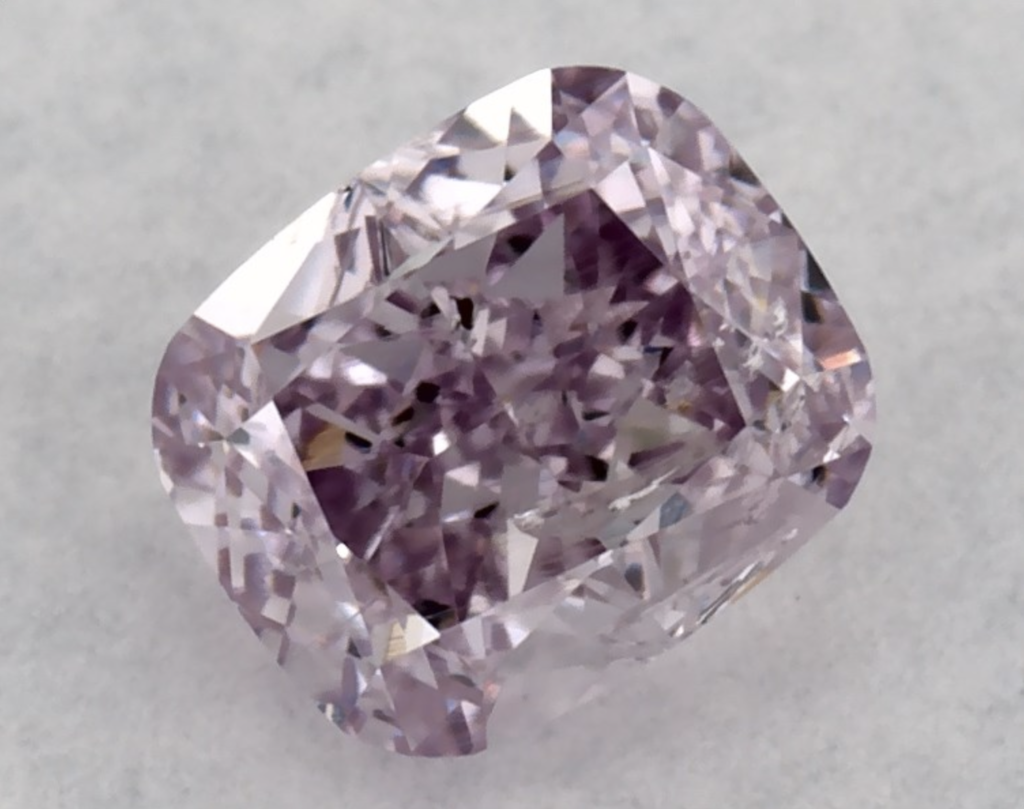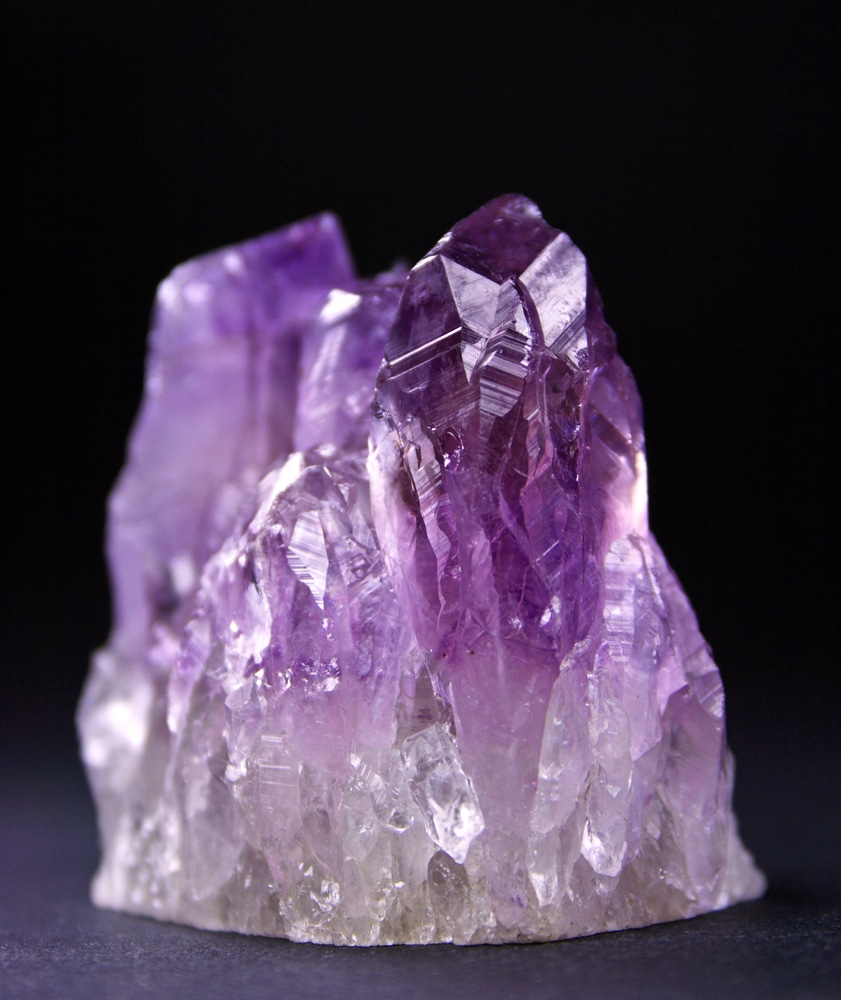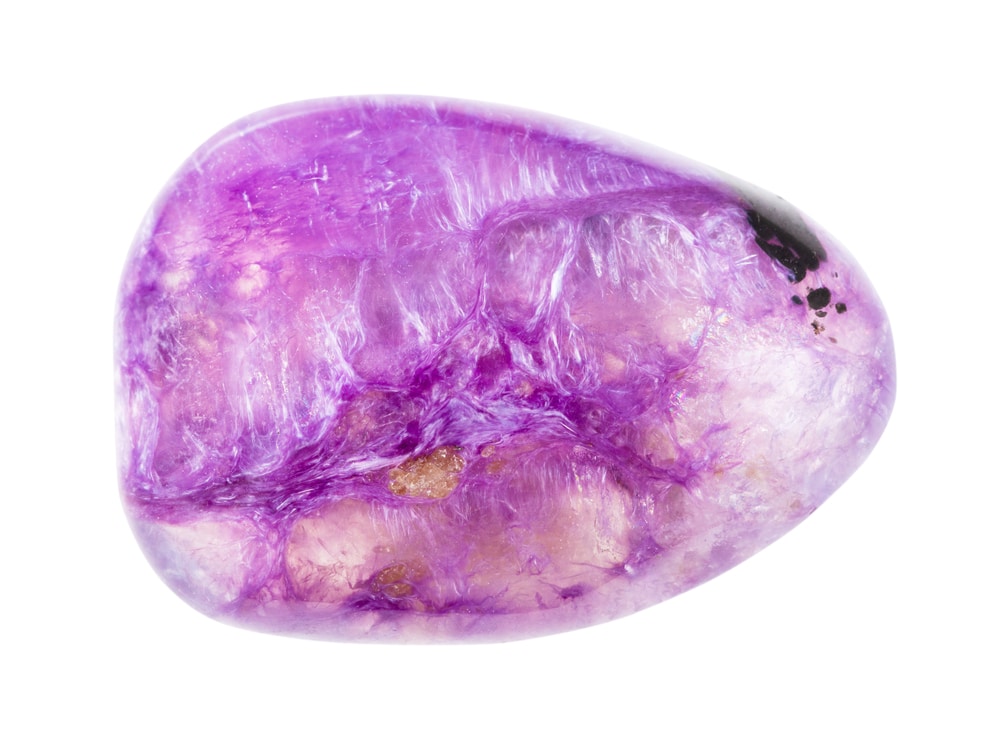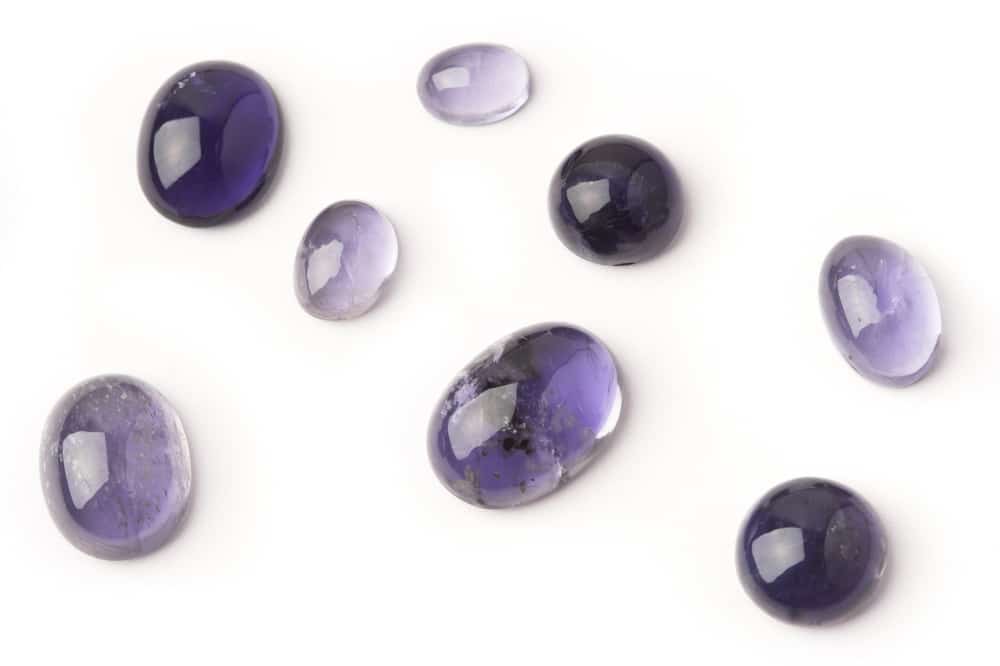Purple is one of the most magnificent colors you can find in a gemstone. There is something special about a ring or bracelet set with purple gemstones that speaks to its wearer’s unique sense of style.
It is both different and distinctive.
Small wonder then that purple has always been a color with special significance and meaning throughout history.
For centuries, purple robes were only worn by people of great wealth, rank and importance, simply because purple is one of the most expensive dyes to produce and it is rarely found in the natural world.
If you think about it, there are fewer purple flowers in nature than there are red, yellow, white, orange or pink ones, for example.
The color purple has always been associated with nobility, luxury and power – and purple jewelry adds a touch of sophistication and elegance to any wearer’s wardrobe.
10 of Our Favorite Purple Gemstones
There are several spectacular types of purple gemstones -and we’ll guide you through the most eye-catching of them all. You will notice that, comparatively speaking, there are not as many types of purple gemstones as there are colorless, green, blue or red ones – all of which are available in literally hundreds of different varieties.
In general, the darker the shade of purple the more expensive the natural gemstone will be, but you will find many that are synthetic and artificially enhanced.
Tip: If you are looking to buy a purple gemstone of any type, you should always ask if it is natural or synthetically enhanced, because the price and potential re-sale value differential will be significant.
1. Purple Diamond

Mohs Hardness Scale: 10
Did you know that diamonds are also available in purple? Probably not. Purple is one of the so-called “fancy” diamond colors. In their natural form purple diamonds are very rare and extremely expensive, and they are created when there is an influx of hydrogen present underground as the stone is undergoing its formation process over billions of years. The color purple comes in many different shades, so different colored diamonds in the purple spectrum are known by different names such as violet, mulberry, lavender, mauve or lilac, representing the shade they most closely match.
The more vivid the purple coloration, the more expensive the diamond is. High quality, natural, dark purple diamonds are much sought after by collectors and diamond enthusiasts alike. That said, however, you can buy synthetic or color enhanced or synthetic diamond alternatives which are much easier on the wallet and to the layman, just as beautiful.
James Allen has a great selection of what they all “earth created,” (meaning natural) purple diamonds with prices ranging from around $3,000 to $190,000, depending on their color saturation, cut, carat weight and overall quality. As of the date of this article, they do not offer synthetic purple diamonds.
2. Amethyst

Mohs Hardness Scale: 7
Centuries ago, amethyst was considered as valuable as rubies, diamonds or emeralds but since large deposits were discovered in Brazil, it has become much more common. Today, amethyst is the most popular type of purple gemstone because it is readily available and less expensive than other purple gemstones on the market.
Amethyst gemstones come in all shades of purple, the deepest coloration being the most valuable and expensive. The one drawback with amethyst is that it is not as durable as other gemstones and can chip or crack over time. It also has a tendency to fade when exposed to long periods of direct sunlight. If carefully maintained though, amethyst jewelry can last a lifetime.
Blue Nile has a superb collection of amethyst rings, necklaces and loose stones with prices ranging from a few hundred dollars to a few thousand, depending on their color and quality.
3. Purple Sapphire
Mohs Hardness Scale: 9
You might be forgiven for thinking that sapphires only come in blue. In fact, sapphires also come in purple and they are formed when chromium and other trace elements are present during their formation under the earth. Purple sapphires are rarer than blue sapphires and are therefore substantially more expensive.
Often mistaken for amethyst, purple sapphires are more durable, harder and less prone to damage than amethyst, making them a great choice for an engagement ring. Whilst blue sapphires and other gemstones are artificially heat treated to bring out a deeper level of coloration, purple sapphires usually have excellent natural coloration, so they do not need it.
Brian Gavin has a magnificent collection of superb oval and emerald cut purple sapphires with prices ranging from around the $16,000 level to over $43,000 level for a high quality, heavy carat weight stone.
4. Purple Garnet
Mohs Hardness Scale: 7.5-8.5
Ranging in color from purple to orange-y red, garnet is available in a wide variety of colors. Of particular beauty is the royal purple garnet, which is a rare hybrid found only in Mozambique, East Africa. The reason for its brilliance lies in the distinctive flashes of red which shine through the intense purple when the stone is held up to the light. Garnet comes in shades of purple which range from magenta to boysenberry to plum.
Prices range from about $500 to $3000 per carat, depending on quality and color.
Check out James Allen for garnet birthstones (January), necklaces and earrings.
5. Purple Spinel
Mohs Hardness Scale: 8
Spinel comes in a variety of colors, but shades of blue and red are the most sought after and are therefore the most expensive. However, purple spinel is much more affordable and is likely to have natural, unenhanced coloration for those purchasers looking for a “real” gemstone. Found in Burma, Tanzania, parts of Afghanistan and Sri Lanka, spinel is relatively durable, so it is a good choice for an engagement ring or other types of everyday jewelry. It is most often found in emerald, cushion, round or radiant cuts as it has an extraordinary brilliance which is shown to its best advantage in all faceted types of cuts.
The cost for purple spinel under 1 carat ranges from $200 to around $500 for deeper coloration. Again, depending upon the color, cut and carat weight, prices can go into the thousands.
Try Africa Gems for a good selection of quality, loose, pre-cut purple spinel.
6. Purple Tourmaline
Mohs Hardness Scale: 7-7.5
Most people buy tourmaline in different colors such as pink, but it does come in a wide range of purple shades too – and it is absolutely stunning when set in a ring or other jewelry. It has a vitreous luster and has brilliant coloration, especially in the different shades of darker purple. Colored tourmaline has flashes of a secondary color, which is called pleochroism, making it flash vibrantly when held up to the light. At 7-7.5 on the Mohs scale it is not the hardest gemstone available, so extra caution is needed to prevent damage. Having said that, purple tourmaline is readily available, affordable and a good alternative to more expensive purple gemstones. Again, ask if your stone has been heat treated as this is common with tourmalines.
Because of its brilliance, most tourmalines are cut with facets to show off the stone’s magnificent sparkle. And the cost? $300 – $600 and above per carat, depending on coloration, clarity and carat weight.
You can find out more about purple tourmaline from ATG Gems
7. Purple Jade
Mohs Hardness Scale: 6
Were you under the impression that jade only came in different shades of green? You would be wrong, in actual fact. Jade is available in many different colors including purple. There are two types of jade; these are nephrite jade (calcium magnesium silicate) and jadeite (sodium aluminum silicate). Of the two, jadeite is rarer and more expensive and is considered more of a high-quality stone. Turkish purple jade, known as turkeyenite has been used in jewelry since the 1980s and is found in only one place in the world – the Bursa region of Turkey. It is gradually becoming more popular for use in intricate carvings and jewelry.
Purple jade can have an opaque, sometimes milky look but also comes in a translucent form. It is smooth and waxy looking. Although it is fairly soft, it is more durable than you might imagine due to its unique composition. Moat jade appears in smooth cuts, in carved form or in cabochons.
The healing and symbolic properties of jade have a long history with the Chinese and it is popular with aficionados of healing crystals all over the world.
Cost: From a few hundred dollars and up, depending upon its quality and color.
Purple and lavender jade is widely available online on sites such as GeMSelect.
8. Charoite

Mohs Hardness Scale: 5-6
You have probably never heard of charoite. It is a spectacular, purple gemstone found only in the frozen mountains of Siberia and was only commercially introduced in 1978. It comes in various shades of lavender, lilac and violet to pure, deepest purple. What makes charoite stand out from other purple gemstones is the unique pattern of swirls which streak across its surface. These patterns are the direct result of its fibrous internal texture. The translucency of the stone adds a sense of depth to these patterns, so that they appear like layers of swirling clouds or feathers. The swirls have touches of black, white and brown mixed into the purple, so charoite has a truly distinctive look.
Charoite has a complicated internal structure composed of various mineral components such as potassium, calcium and silicon. It is categorized as an opaque stone and is most often cut and polished into ovals, pears and cabochons.
Because charoite has such interesting patterns and coloration it is perfect for one-of-a-kind pieces, pendants, bracelets or earrings. Charoite is relatively inexpensive, yet altogether eye-catching.
And the cost? It is an absolute bargain, from a few dollars per carat and up, depending on quality and color.
Find a selection of charoite rings on GeMSelect.
9. Purple Chalcedony
Mohs Hardness Scale: 7
Chalcedony is also a stone considered by many to have special healing and mystical powers, but it is quite beautiful in its own way. Available in many different colors, it comes in various shades of purple, from dark plum to pale lilac. It is mostly translucent, often vitreous and with a waxy look to it. When opaque, purple chalcedony can contain swirls of cream and other darker colors, giving it an appealing depth and rich natural coloration.
Chalcedony is a durable gemstone with a microcrystalline structure. It is compact and has no cleavage so it will not chip, crack or break. Chalcedony is mostly cut in cabochon or carved into special engravings, necklaces, earrings or other types of jewelry. It is especially suited for ethnic or bohemian style jewelry.
Chalcedony is inexpensive and costs from a few dollars to hundreds depending on quality and color.
You’ll find purple chalcedony jewelry available from many different online sources, but for loose stones try Africa Gems.
10. Purple Iolite

Mohs Harness Scale: 7-7 1/2
Iolite, which is a variety of cordierite, is a magnesium iron aluminum cyclosilicate. Once called the “water sapphire” iolite comes in various stunning shades of blue, grey and purple. Iolite is pleochroic, which means it transmits light differently when viewed from different directions. Iolite was used by the Vikings to navigate their trips as it cancels out haze, mist and clouds making things clearer, hence its other name as the “Viking’s Compass.”
Iolite cannot be heat treated to improve its color or clarity. It looks very much like a sapphire in terms of its brilliance and beauty but does not have the hardness or durability of a sapphire, as it is susceptible to chipping or cracking if not properly maintained. Though a popular, brilliant gemstone – and a very affordable one – it is not highly valued. Experts recommend mounting iolite in a halo or bezel setting to better protect the stone from damage.
Prices for iolite range for 1- 5 carats can be less than $100, 5-10 carats up to $200, depending on quality and coloration.
Check out the selection of iolite on Gem Rock Auctions
Conclusion
This is by no means a comprehensive list of all purple gemstones available. Some others include Purple Jasper, Rhodolite Garnet, Sugilite, Purple Kunzite, Siberite, Purple Agate, Taffeite, Thulite, Hackamite, Purpurite, Phosphosiderite, Marialite, Purple Tiger Eye, AngelSilica, Amzez and Purple Fluorite. All have varying degrees of rarity, availability and durability and many are not used at all in jewelry as they are easily prone to damage.
The color purple is a royal, powerful and distinctive choice in gemstone. It says you are different, special and somehow, unique.
Purple makes a statement.
